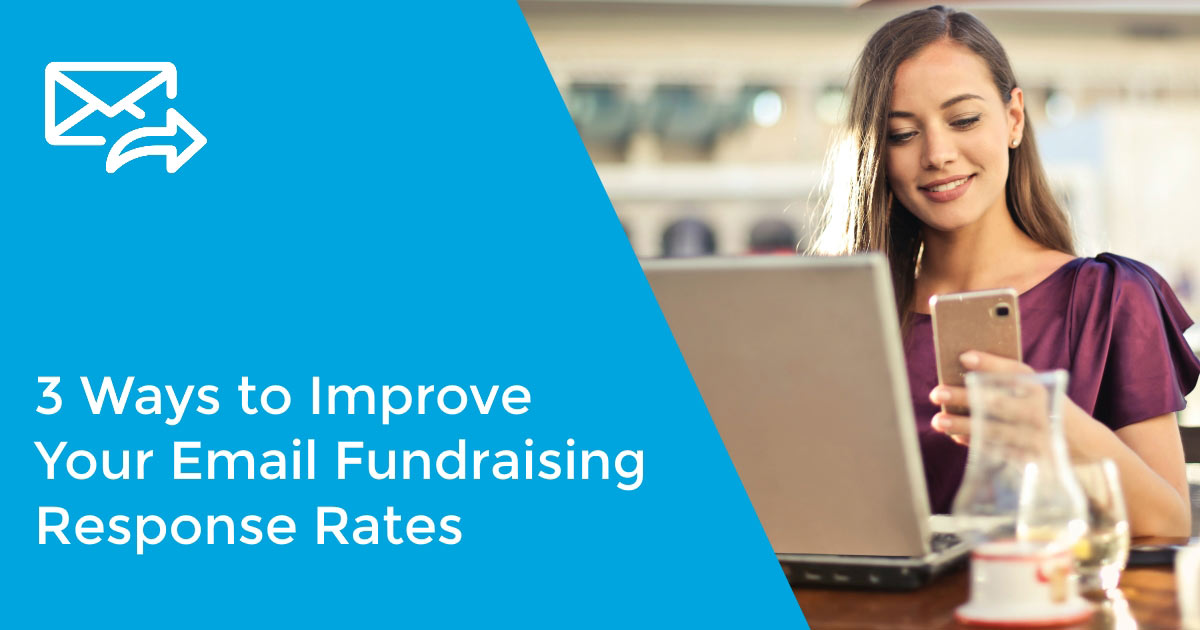Nonprofit Technology & Fundraising Blog
Subscribe to our mailing list
August 13, 2020 |

In 2019, email fundraising response rates increased by 1%. M+R Benchmarks has never reported a year-over-year increase for this metric. This is great news for nonprofit organizations that are increasingly reliant on virtual fundraising tactics. Email’s impact as a fundraising tool is growing. If your email game is not where it needs to be, check out these three ways you can optimize your email fundraising efforts:
Without an engaged email subscription list, you won’t have supporters to open and read your fundraising emails. The best way to increase the amount you raise from your supporters via email is to grow your list of subscribers. In 2019, for every 1,000 fundraising messages sent, nonprofits generated $45 in revenue. The key to getting supporters to sign up is to make the benefit of joining your nonprofit’s email list clear. Tell supporters what they’ll gain from joining your list and then deliver on that promise.
Using DP Online Forms, you can create a branded email sign-up form in minutes to embed in your website, include on your social media pages and use at events or other fundraising activities to encourage subscriptions.
Donor segments are a vital part of any fundraising strategy. This is especially true for email fundraising. Targeted email campaigns based on donor segments are more effective and result in higher open rates than emails that are not targeted. Targeted emails provide information that is relevant and interesting to their intended audience.
Using criteria that you define, such as monthly donors, you can group supporters into smaller, connected groups and tailor your email communications to their interests. Donors can be grouped by geographical location, how much they give, how recently they gave, what campaigns they have given to, if they are part of your organization, and more.
Segmented emails help you build better donor relationships and result in higher giving amounts because they are personalized for their specific audience. They also increase volunteer support, promote better event attendance, and build awareness of your programs or advocacy efforts.
To learn how to use DonorPerfect’s Constant Contact integration and dynamic lists to segment donors, read The Key to Better Email Marketing: Segmentation on our blog.
Your email’s content is more than just the body of the email itself. It includes the sender, subject line, preview text, email body, and calls-to-action. By optimizing each of these areas, you’ll improve the open, click thru and the response rate for your fundraising emails./
Many email recipients decide if they will open an email based on who it’s from. Check that your email sender address is a real person, such as staff or Board members. Having emails come from an actual person at your nonprofit builds the donor relationship much more than having it come from a generic organization account. /
Boost open rates with interesting, personalized subject lines that convey to donors that your email was written for them and covers something recent or meaningful. Use an email subject line analyzer, like this free tool from Co-Schedule, to improve your subject line.
Preview text is the small snippet of text that will display in your supporter’s email software when they receive your message. Use this text to convey the reason supporters would be interested in this email and entice them to read your message (e.g., “Learn how your donations changed this child’s future”)
The purpose of your email defines what content to include. Nonprofits frequently send thank you notes, donation updates, merchandise promotions, impact stories, and inspirational, mission-based content. Save time creating your emails by repurposing content from other channels, like your blog or website. Tailor the email’s messaging to share why you thought this content was important to your supporters.
If you don’t include a clear call to action button in your email, you’re missing out on an opportunity to tell supporters what to do next. Even if your email is purely informational, such as an update on donation use, always include a call to action to engage supporters. Some typical CTAs are:
PRO TIP:
DonorPerfect’s Monthly Giving Communications Template Kit provides done-for-you email templates to help you launch and promote your monthly giving program. Download them today to use in your next email campaign.
DonorPerfect’s Constant Contact integration provides everything you need to drive results for your organization through professional, effective communications. Watch the recording of this free live webinar to learn about the many features Constant Contact has that help nonprofits to fundraise.
Follow us on social!